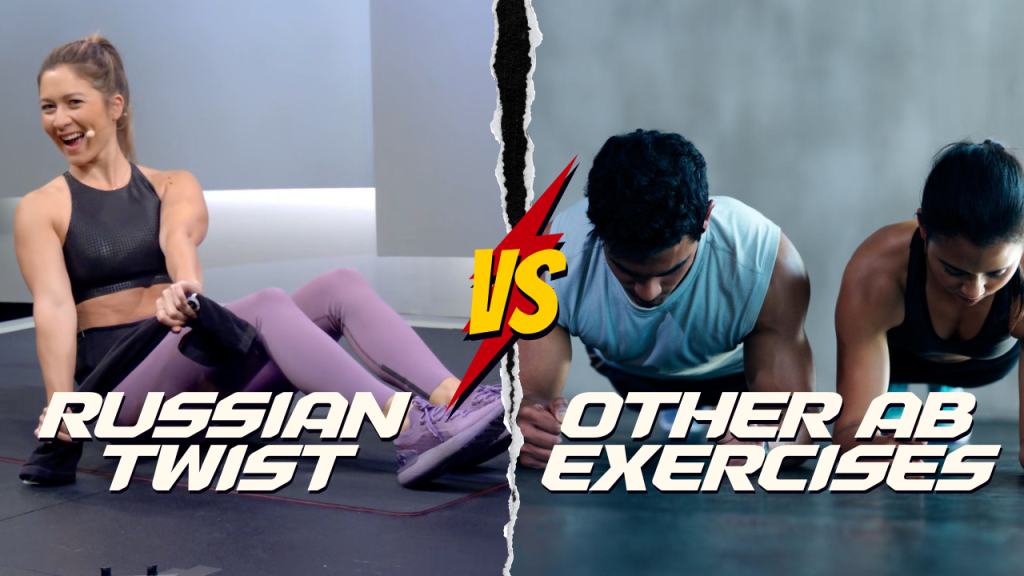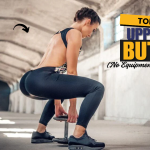Six-pack abs aren’t just built in the gym—they’re sculpted with smart choices. If you’ve ever Googled “best ab exercises,” chances are you’ve stumbled across the Russian twist. But is it truly the king of core moves, or are there better challengers in the workout arena? Let’s break down the Russian twist and compare it with other popular ab exercises to find out which is best for building a rock-solid core.

Table of Contents
What Is the Russian Twist?
The Russian twist is a seated core exercise that involves rotating your torso side to side, often while holding a weight or medicine ball. It primarily targets the obliques but also engages the rectus abdominis, transverse abdominis, and hip flexors.
How to Do It:
- Sit on the floor with your knees bent and feet slightly off the ground.
- Lean back slightly to form a V-shape with your torso and thighs.
- Hold a weight with both hands and twist your torso to the right, then to the left.
- Keep your core engaged and your spine neutral.
Benefits of the Russian Twist
- Excellent for Oblique Strengthening: It’s one of the most targeted moves for your side abs.
- Improves Rotational Stability: Great for athletes in sports like tennis, baseball, or golf.
- Balance & Coordination: Involves keeping your body steady while rotating—engaging multiple muscle groups.
The Competition: Other Popular Ab Exercises
Let’s see how the Russian twist stacks up against some top-tier core exercises.
1. Plank
- Muscles Targeted: Transverse abdominis, rectus abdominis, glutes, shoulders.
- Pros: It builds deep core strength and improves posture.
- Cons: Doesn’t engage obliques as much unless variations are added (e.g., side plank).
Russian Twist vs. Plank:
If your goal is rotational strength, Russian twist wins. For overall core endurance and back health, the plank is a better choice.
2. Bicycle Crunch
- Muscles Targeted: Rectus abdominis, obliques, hip flexors.
- Pros: Great dynamic movement, combines crunch and rotation.
- Cons: May strain the neck if done incorrectly.
Russian Twist vs. Bicycle Crunch:
Both target obliques, but bicycle crunches also burn more calories due to their cardio component. Russian twists offer better control and isolation.
3. Leg Raises
- Muscles Targeted: Lower abs, hip flexors.
- Pros: Effective for targeting hard-to-reach lower abs.
- Cons: Can stress the lower back without proper form.
Russian Twist vs. Leg Raises:
Russian twists hit the sides; leg raises hit the bottom. Combining both gives you 360-degree core activation.
4. Mountain Climbers
- Muscles Targeted: Full core, shoulders, glutes.
- Pros: High-intensity, cardio-driven core workout.
- Cons: May fatigue quickly; not great for beginners.
Russian Twist vs. Mountain Climbers:
Twists offer more control and less cardio, while mountain climbers are great for fat burn and speed.
5. Cable Woodchopper (Advanced Option)
- Muscles Targeted: Obliques, lats, shoulders, hips.
- Pros: Functional and mimics real-life movement.
- Cons: Requires access to cable machines.
Russian Twist vs. Cable Woodchopper:
Woodchopper is a more powerful, functional upgrade of the Russian twist—ideal for athletes or advanced fitness enthusiasts.
Which One Is Best for Your Core?
There’s no one-size-fits-all answer. Here’s how to choose:
| Goal | Best Exercise |
|---|---|
| Oblique Definition | Russian Twist or Bicycle Crunch |
| Core Stability & Strength | Plank |
| Functional Power | Cable Woodchopper |
| Fat Burning & Cardio | Mountain Climbers |
| Lower Ab Targeting | Leg Raises |
Pro Tip: Combine 2–3 of these exercises in a circuit to hit your core from all angles.
Making the Russian Twist More Effective
To upgrade your twist:
- Add weight (medicine ball, dumbbell, or plate)
- Slow down the rotation for more time under tension
- Keep your feet off the ground
- Try it on a decline bench or BOSU ball for an extra challenge
Are Russian Twists Safe for Everyone?
While effective, Russian twists aren’t ideal for:
- People with lower back pain
- Those recovering from spinal injuries
Alternative: Try standing oblique crunches or side planks instead.
Conclusion: Don’t Just Twist—Train Smart
Russian twists are powerful, but they’re even better as part of a comprehensive core routine. Whether your goal is aesthetic abs, improved posture, or athletic performance, mixing multiple core exercises ensures you’re training smarter, not just harder.
Frequently Asked Questions (FAQs)
Are Russian twists effective for building abs?
Yes, Russian twists are highly effective for strengthening the obliques and overall core. However, for visible abs, they should be combined with a balanced diet and full-body fat-burning workouts.
Do Russian twists burn belly fat?
Not directly. While they strengthen abdominal muscles, fat loss comes from overall calorie expenditure. Combine twists with cardio and proper nutrition for fat-burning results.
Is the Russian twist bad for your back?
It can be if performed with poor form or if you have existing lower back issues. To avoid injury, keep your spine neutral, avoid excessive twisting, and engage your core. Consult a professional if unsure.
Which muscles do Russian twists work?
Russian twists primarily target the obliques, but they also engage the rectus abdominis, transverse abdominis, hip flexors, and lower back stabilizers.
What’s better: Russian twists or planks?
Both have unique benefits. Russian twists focus on rotational strength and obliques, while planks enhance overall core stability and endurance. Incorporating both into your routine is ideal.
Can I combine Russian twists with other ab exercises?
Yes! In fact, combining them with planks, bicycle crunches, or leg raises creates a well-rounded core workout and improves results.





